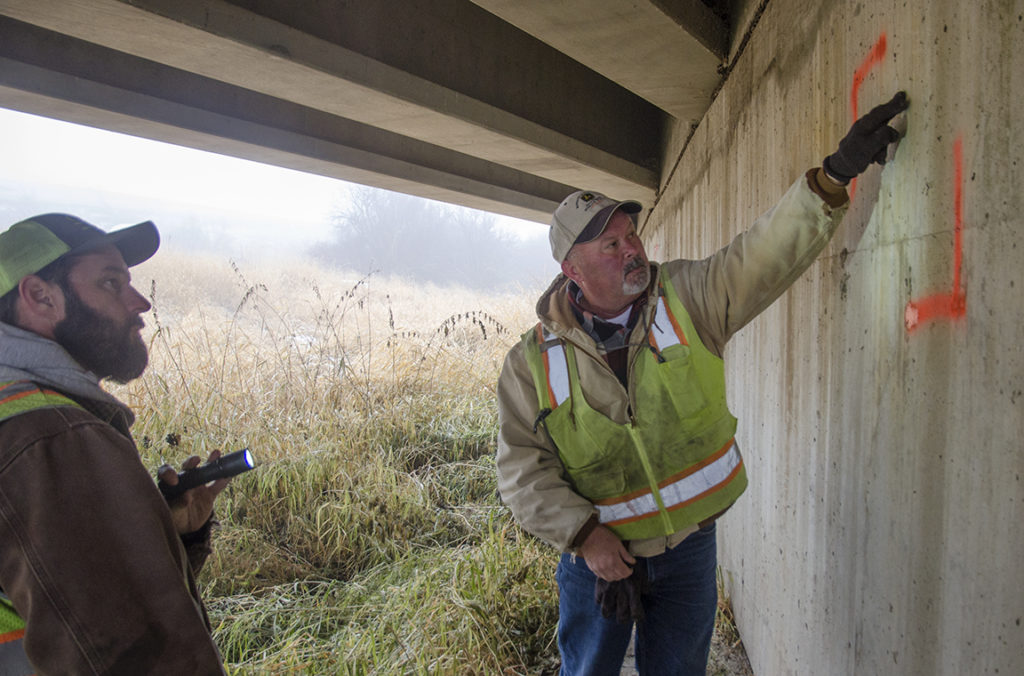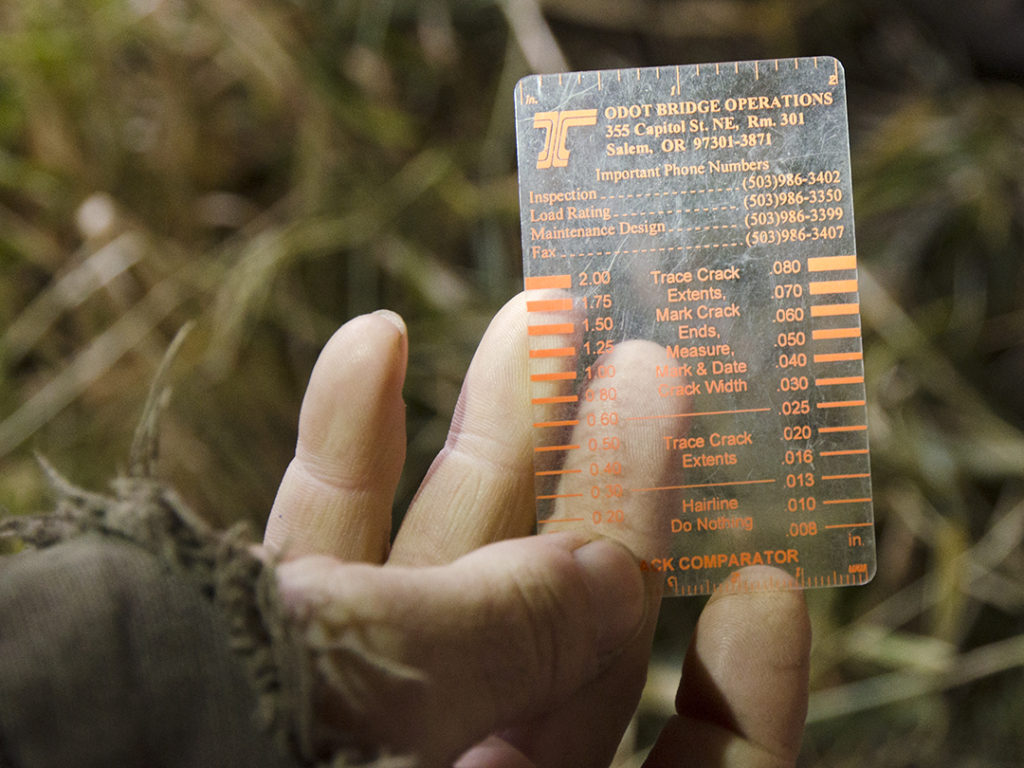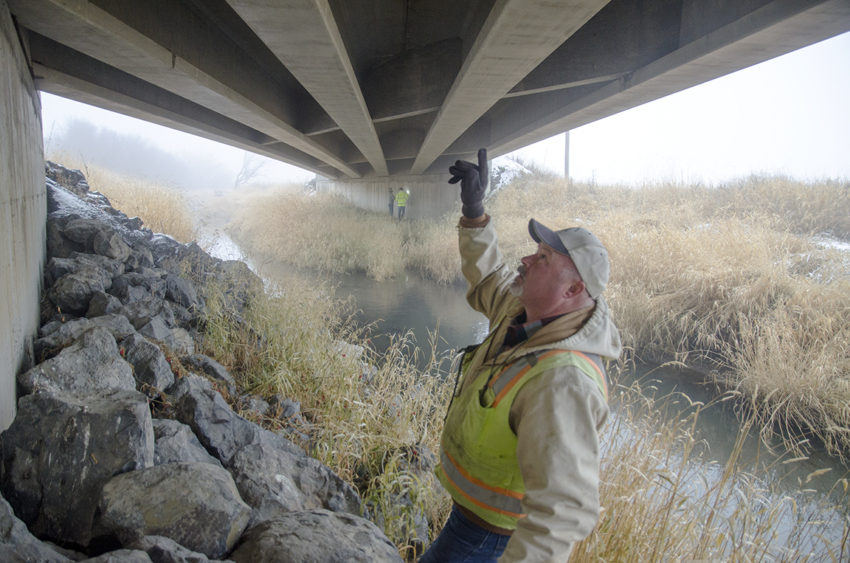A passing car rumbled overhead as Bob Sevedge scrambled along the rocky bank of Union Flat Creek to inspect the underside of a concrete bridge last December. He scanned the beams and bracing for any signs of damage.
Sevedge, who has served as county bridge supervisor since 2009, monitors 335 bridges throughout Whitman County. His crew often inspects more than 30 bridges a month, ranging from small drainage culverts to historic arch bridges.
“A bridge is a bridge,” he said, “but they’re all different.”
The 120-foot Hatley bridge along Wawawai-Pullman Road underwent a significant retrofit in 2015. Sevedge’s crew pointed out a couple small cracks running in one concrete abutment. Most cracks date back to the construction process, he said, but they mark them with orange spray paint and note them for future monitoring.
“Generally, all our bridges are in really good shape,” he said.
Several cities and the state Department of Transportation also monitor another approximately 100 bridges. Whitman County Watch recently obtained a snapshot of inspection data for the 439 bridges located throughout the county. Sevedge and other inspectors log dozens of structural metrics into a central Washington State Bridge Inventory System database that tracks construction updates, apparent damage or wear, and detailed photos of thousands of structures.
The Hatley bridge has a sufficiency rating of 96.94 points out of 100. The state’s inspection manual describes the sufficiency rating is an automatically calculated number based on the bridge’s structural adequacy rating, the functionality of the bridge and how essential the bridge is to public use.

As of January, 221 of the bridges in Whitman County (50 percent of the total 439) have sufficiency ratings over 90 points. Six bridges, mostly railroad bridges, did not have any ratings listed. Explore our interactive map of all bridge ratings below.
Sevedge explained a bridge’s sufficiency rating must fall below 45 points before it qualifies for state repair funding. Whitman County usually pays to repair or replace its own bridges before they rate that low.
“We generally don’t ever let our structures get that bad,” he said. “You’d just be taking your chances not replacing them.”
Five local bridges have current sufficiency ratings below 45 points. Two of those bridges carry state highways through Colfax (rated 29.9 and 30.37). The Wagner bridge runs over Almota Creek in southern Whitman County (36.6) and the Bruce bridge sits near the stateline just south of Tekoa (44.31). The last bridge is a private, gated bridge near the Palouse Empire Fairgrounds (36.11).
The longest active bridge in the county is the 603-foot Palouse River Bridge along SR 26 just west of Colfax, according to the data. The bridge has a current sufficiency rating of 50.79 points.
Update with WSDOT response, Feb. 26: State Bridge & Structures Engineer Mark Gaines said the ratings primarily help guide the prioritization of preservation efforts and funding. He emphasized that low ratings or a classification of structural deficiency does not indicate concerns a bridge might fail. State inspectors would take immediate action on any conditions they considered hazardous.
“Those [bridges] don’t pose safety risks,” he said. “We address those right away.”
Gaines noted several area bridges, including the State Route 26 spur bridge in north Colfax, remain listed as high priorities for replacement or deck rehabilitation. The SR 26 spur bridge underwent repairs to reinforce its pedestrian walkway in 2015 and received an asphalt overlay last year, but is still listed for replacement as part of the long discussed re-alignment of SR 26 and US Route 195 intersection.
“We are somewhat at the mercy of the funding we get,” he said, estimating that work might start sometime in the next five years.
Dozens of distinct metrics contribute to the overall ratings of the bridges. Inspectors look at surface wear, water clearance, weight and width capacity, average daily traffic surveys as well as any apparent structural deficiencies. Spalling, cracks or other wear will decrease a bridge’s rating. Gaines said damage to just 2 percent of a bridge’s deck area can result in a deficient rating.
The “structural adequacy rating” represents another calculated assessment of several metrics to track the condition of a bridge. Ratings above 5 indicate the bridge meets all modern minimum criteria. Ratings of 4 indicate a bridge that falls below modern standards, but above minimum “tolerable” limits.
The DOT manual states bridges rated at 3 or below qualify as “basically intolerable requiring high priority corrective action” or replacement.
The county has two bridges rated at 3, both along US 195 in Colfax. Just one bridge — the gated fairgrounds bridge — is rated at 2.
About 40 bridges have structural adequacy ratings of 4, suggesting they do not meet all modern standards. Many standards for weight capacity and width have increased over the years as heavy trucking traffic has grown. Sevedge noted newer standards can result in bridges becoming “functionally obsolete.”
“We basically have a bridge that’s in good shape,” he said, “[But] farmers can’t get their combines across them.”
The recent data snapshot has 68 bridges designated as functionally obsolete and nine bridges listed as structurally deficient. Gaines said federal standards have recently moved away from those classifications to instead characterize bridges as in good, fair or poor condition.
Find more WSDOT information on bridge ratings and a list of state bridges rated in “poor” condition here.
Sevedge said most bridges get inspected every two years. The county’s 22 wooden bridges receive annual inspections. Any structures with potential concerns typically get more frequent monitoring.

Many inspections require crawling under cramped substructures or wading into streams to check pilings. Sevedge said the state handles the one bridge in the county that requires a diver to inspect deepwater supports.
Back in December, co-inspector Chad Kincheloe and working foreman Robby Johnson joined Sevedge on the day’s rounds. Each man wore a neon green safety vest as thick fog choked visibility along the roadway.
At the small Chambers bridge, just off Highway 195 south of Pullman, they checked for any new signs of damage to the concrete rails on either side. Sevedge said the bridge has a long history of getting smashed up as large trucks make the corner onto the highway. His office gets a call about it a couple times a year.
“I just cringe every time,” he said.
A large chuck of concrete curb hangs broken off one end. Kincheloe and Johnson hunched under the low substructure. They measured water depth, noting any silt build up or fresh erosion. The bridge has a sufficiency rating of 81.97 out of 100.

The bridge crew covers the entire county and works in almost any conditions. While the work does not involve much risk, Sevedge said, they do encounter a lot of raccoon nests.
Building new bridges makes for some of the most rewarding work, he said. County engineers problem solve new crossings and apply new technology to old structures. The county usually builds or replaces one or two bridges a year. He said the recently passed county road levy would provide much-needed support for those efforts.
Permitting requires close collaboration with state wildlife and historic preservation agencies. Sevedge said he has enjoyed working with cultural experts and fishery managers. In one project near the Snake River, a salmon expert designed an ideal riverbed for nesting, carefully arranging rocks to provide natural shelter.
“When we do a bridge project,” he said, “we always leave it better than we found it.”
WHITMAN COUNTY BRIDGES
Green dots mark bridges with structural adequacy ratings of 5 or more (above modern standards). Yellow dots mark bridges rated at 4 (below modern, but above minimum tolerable). Orange dots mark bridges rated as high priorities for repair or replacement. Gray dots mark bridges with no listed rating.
